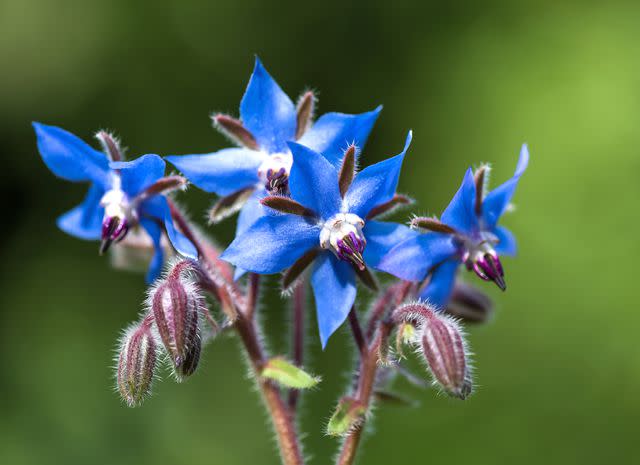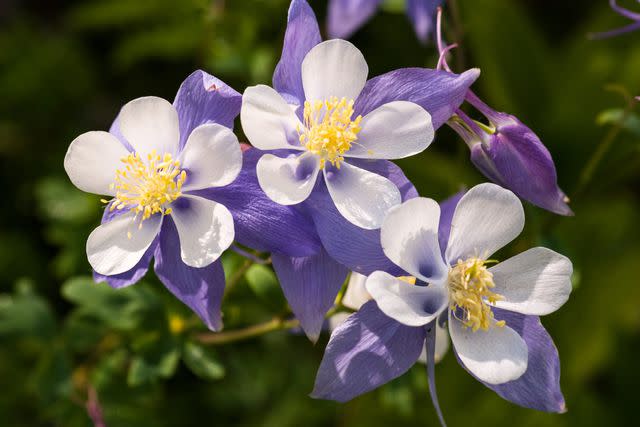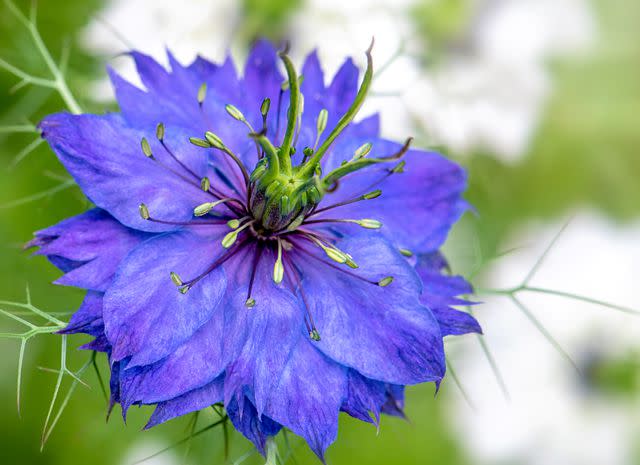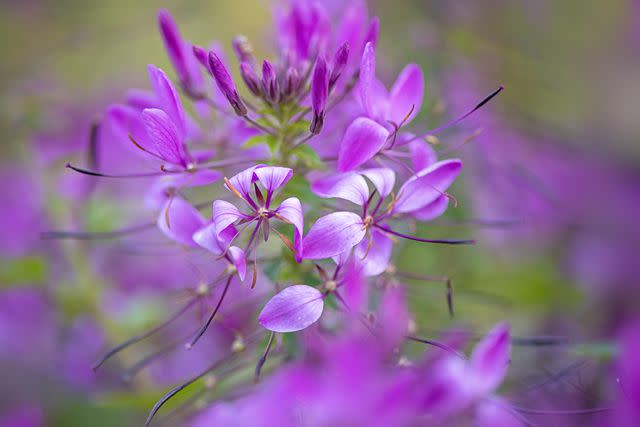18 Self-Seeding Flowers That Produce New Blooms Every Year—With Less Work for You
All of these flowers drop seeds in the garden, which germinate and give way to blooms the following year.

Getty Images
Planting flowers that self-seed is a wonderful way to ensure you'll have blooms each growing season with minimal work on your end. Before they die, these plants drop seeds in your garden that will germinate on their own the following year, providing unexpected blooms and color to your landscape.
Self-sowing plants are also a big draw for pollinators. These plants are some of the first to flower, meaning they're an early pollen and nectar source for birds, butterflies, and other wildlife. Plus, self-sowing plants are also known for being low-maintenance. Once established, they often require little care beyond what the natural climate has to offer.
Ahead, we're sharing expert-recommended self-seeding flowers you should grow in your garden.
Related: 15 Pollinator Plants That Will Attract Birds, Bees, and Butterflies to Your Garden
Alyssum

Maria Mosolova / Getty Images
Alyssum (Lobularia maritima) has tiny white or purple flowers that entice pollinators. "Alyssum regularly makes its home in yards, gardens, and cottage landscapes where it invites much-needed pollinators," says Linda Hayek, Horticulturist for Eden Brothers.
Zones: 5 to 9
Size: 3 to 10 inches tall x 2 to 4 inches wide
Care requirements: Partial to full sun; well-draining soil
Amaranth

Bilanol / iStock / Getty Images Plus
Producing a single burgundy flower that looks like it has multiple feathers jetting out, amaranth (Amaranthus, cruentus) will keep coming back season after season on its own. "Amaranth is one of the most prolific self-seeding plants I've ever grown," says Miya Sohoza, ornamentals product manager for Harris Seeds and a National Garden Bureau member. "Volunteer plants show up every year in garden beds and throughout the farm."
Zones: 2 to 11
Size: 2 to 4 feet tall x 1 to 2 feet wide
Care requirements: Partial to full sun; well-draining soil
Bee Balm

Angie Cottingham
Bee balm (Monarda didyma) is a wildflower native to North America and attracts beneficial insects and pollinators. "If you don't want your bee balm to self-seed, you can easily thin them out," says Nancy Ketchmark, owner of Flowers Contained. She prefers to let nature do its thing and have them self-seed in her garden. "The more the merrier with these colorful pollinator attractors,'' she says.
Zones: 3 to 9
Size: 10 to 48 inches tall x 10 to 36 inches wide
Care requirements: Partial to full sun; well-draining soil
Related: 15 Full-Sun Perennials That Come Back Bigger and Better Every Year
Black-Eyed Susan

Jon Rehg / GETTY IMAGES
Black-eyed Susan (Rudbeckia hirta) has vibrant yellow flowers with the shape of a daisy but are bigger and loved by pollinators. "The butterflies and bees will flock to bright yellow Rudbeckia," says Ketchmark. "They are easy to control if you only want them in a certain area; just pick the few that will spread."
Zones: 3 to 9
Size: 2 to 3 feet tall x 1 to 2 feet wide
Care requirements: Full sun; well-draining soil
Borage

Oksana_Schmidt / Getty Images
A hardy herb that produces bluish flowers that have an aroma of cucumber, borage (Borago officinalis) will crop back up the following season. "Borage is a great pick for gardens with challenging soil," says Gail Pabst, horticulturist and marketing director for the National Garden Bureau. "It tolerates drought well and is typically left untouched by deer."
Zones: 2 to 11
Size: 12 to 36 inches tall x 9 to 18 inches wide
Care requirements: Partial to full sun; well-draining soil
Calendula

With orange or yellow flowers boasting multiple slender petals, calendula (Calendula officinalis) makes for a beautiful bloom in the backyard and is a great choice for adorning culinary dishes. "Often grown for its edible petals and homeopathic uses, calendula is a hardy annual that will self-seed if given the room in the garden to do so," says Sohoza.
Zones: 2 to 11
Size: 1 to 2 feet tall x 1 to 2 feet wide
Care requirements: Partial to full sun; well-draining soil
California Poppy

ejs9 / Getty Images
The California poppy (Eschscholzia californica) shines on hillsides and in border gardens, bringing a vibrancy to the landscape. The California poppy is majestic and elegant, says Hayek.
Zones: 6 to 10
Size: 12 to 18 inches tall x 12 to 18 inches wide
Care requirements: Full sun; well-draining soil
Related: 25 Flower Bed Ideas That Will Inspire Your Garden Design
Columbine

earleliason / Getty Images
Columbine (Aquilegia spp.) has unique flowers that hang downward with nectar spurs that go beyond the petals. This makes it easy for pollinators to access the nectar. "It's always a surprise to see where columbine will pop up in the spring," says Ketchmark. Plus, the colorful blooms bring a lot of color.
Zones: 3 to 8
Size: 1 to 3 feet tall x 1 to 3 feet wide
Care requirements: Partial to full shade; well-draining soil
Cosmos

Producing beautiful pink blooms in various shades, cosmos (Cosmos bipinnatus) liven up any outdoor space. "An incredibly colorful flower that is both hardy and beautiful, cosmos are a versatile variety that can thrive in just about any climate and any soil condition," says Hayek.
Zones: 2 to 11
Size: 2 to 4 feet tall x 2 to 3 feet wide
Care requirements: Full sun; well-draining soil
Hellebore

Clive Nichols / Getty Images
A drought-tolerant perennial flower, hellebores (Helleborus spp.) are wonderful to have in your flower bed. "The seeds on Hellebore are so big that they easily fall out and add new plants around the first plant," says Hayek. "What a treat to end up with another hellebore plant."
Zone: 3 to 9
Size: 9 to 18 inches tall x 12 to 24 inches wide
Care requirements: Full sun to full shade; moist, well-drained soil
Purple Giant Hyssop

Eve Livesey / Getty Images
Purple giant hyssop (Agastache rugosa) produces elongated blooms that attract pollinators. "With beautiful purple flowers, the seedlings carpet the ground around parent plants and grow out in the fall," says Zeeb. Her favorite variety is Golden Jubilee.
Zone: 4 to 9
Size: 1 to 3 feet tall x 1 to 2 feet wide
Care requirements: Full sun; well-drained soil
Related: 15 Colorful Flowers That Will Brighten Up Your Garden
Love-in-a-Mist

Jacky Parker Photography / Getty Images
Love-in-a-mist (Nigella damascena) is a classic annual that features solitary blue blooms above airy foliage. "The spent flowers transform into unique, egg-shaped seed capsules, perfect for drying in bouquets," says Pabst.
Zone: 2 to 11
Size: 8 to 20 inches tall x 3 to 6 inches wide
Care requirements: Partial to full sun; well-drained soil
Purpletop Vervain

Jim Cook / Getty Images
A hardy perennial, purpletop vervain (Verbena bonariensis), has multiple tiny flowers. "Verbena is one of the most hardy and consistent self-seeding plants I've known," says Sohoza. "It can grow under a wide range of conditions and thrives as a self-seeding plant."
Zone: 8 to 11
Size: 9 to 12 inches tall x 12 to 18 inches wide
Care requirements: Full sun; well-drained soil
Snapdragon

Getty Images
Snapdragons (Antirrhinum majus) are an excellent cool-weather crop that blooms throughout spring. "If you can tempt yourself not to cut any blooms, let the flowers go to seed to find new plants in the fall," says Zeeb, adding that her favorite varieties are Rembrandt and Night Day.
Zone: 7 to 11
Size: 6 to 48 inches tall x 6 to 12 inches wide
Care requirements: Partial to full sun; well-drained soil
Related: 20 Pink Flowers That Will Add Timeless Elegance to Your Garden
Spider Flower

Jacky Parker Photography / Getty Images
Spider flower (Cleome) goes by many names, including stinking clover and rocky mountain bee plant. Many gardeners may opt for other flowers since spider flower doesn't typically flower until it's established. "With blooms resembling delicate spiders, the spider flower is an eye-catching annual available in white, pink, and purple," says Pabst. "While not fragrant, these beauties attract butterflies and hummingbirds to the garden."
Zone: 10 to 11
Size: 18 to 60 inches tall x 12 to 24 inches wide
Care requirements: Partial to full sun; well-drained soil
Tickseed

Tickseed (Coreopsis hybrida), known for its seeds that resemble ticks, are a low-maintenance flower. There are numerous varieties with a range of hues. Want a bounty of these flowers for the following season? "If left to self-seed, flowers will be finished by the end of summer and reborn again during next year's spring," says Zeeb.
Zone: 2 to 11
Size: 2 to 4 feet tall x 1 to 2 feet wide
Care requirements: Full sun; well-drained soil
Viola

Mimi Ditchie Photography / Getty Images
There are numerous types of violas (var. hortensis) with a range of hues to choose from, including white, yellow, orange, pinks, and purples as well as multi-colored. These self-seeding plants will bring vibrancy and color to the landscape before other flowers bloom. "Violas enjoy the cold stratification that winter brings and will provide you with an early and hardy garden," Sohozo says.
Zone: 2 to 9
Size: 3 to 10 inches tall x 3 to 12 inches wide
Care requirements: Partial to full sun; well-drained soil
Related: A Visual Guide to Edible Flowers—and How to Use Them
Zinnia

wjarek / Getty Images
Zinnias are a popular flower to brighten up a garden and for welcoming beneficial insects. These flowers with multi-layered petals self-seed, too. "You may introduce zinnias to your landscape in beds and borders for a bright pop of electric color," says Hayek. "Then, enjoy them for years to come as they are heavy re-seeders, especially prolific in the warmer zones."
Zone: 3 to 10
Size: 12 to 48 feet tall x 6 to 18 inches wide
Care requirements: Full sun; well-drained soil
Read the original article on Martha Stewart.

